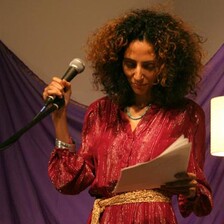New Orleans, United States 14 February 2007
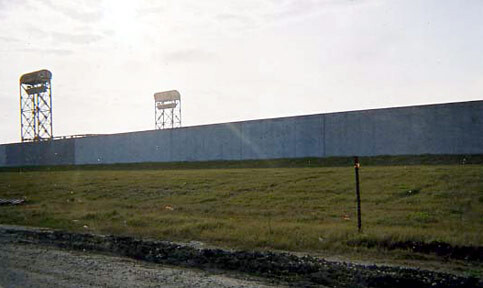
The new levee in the lower ninth ward, built after the old one collapsed during Hurricane Katrina. The grassy expanse in front of the wall was once filled with houses. They were destroyed in the storm. Although taller and thicker, it is no more well-equipped to ward off hurricanes than the one that preceded it. Both are built to withstand a level 3 hurricane — Katrina was level 5. (Lora Gordon)
From the Gulf Coast to the West Bank: New Orleans and Palestine: January 19, 2007
I’m still in New Orleans. It’s so much like Palestine it’s eerie. It’s a different kind of devastation than right after the storm. Some of the worst wreckage has been cleaned up — there are no longer throngs of people camping out on the I-10 Causeway or waterlogged bodies lining the streets. Now it’s the emptiness that is most striking. Some parts of the city are like a ghost town.
We walked down street after street the other day, canvassing in the Seventh Ward, and it was hard to find anyone at all. There’s an extreme sense of shell shock. Every time we found someone there was a strange feeling that they were the only ones left after a bomb had hit.
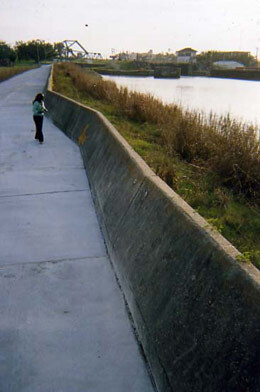
Levees. To the foreground, the lower Ninth Ward levee, an ineffective concrete wall that extends around ten feet above ground and ten feet below. In the background, within walking distance, is the boundary of a richer, whiter neighborhood. At the boundary, the levee immediately changes from a concrete wall to a large grassy mound of earth, approximately twenty feet high and aesthetically pleasing. That neighborhood was relatively untouched by the storm and has since been rebuilt. (Lora Gordon)
In one of the streets, we stood in a crater the width of the road, maybe a foot deep, which had been there since the storm. Out of the empty street, so empty and so stark it could have been a backdrop to a film, a man appeared. It was hard to tell which was more surreal, the human being emerging from the wreckage or the wreckage itself. Under the clear sky and the beating January sun, he told us about watching his neighbor’s two-year-old drown, about the FEMA trailer parks and his own destroyed house, his eyes far away, looking through us as he spoke. “But everyone’s got a story,” he added, almost reverently, as though that fact were itself larger than his own story. He was back to rebuild, one of the first in his neighborhood to return.
It doesn’t feel at all like a year and a half has passed since the storm. The city is half the size it was — from a population of 485,000 to around 250,000. [1] Most of the missing residents are black and poor or working class; a city that was once 67 percent black is now estimated to be less than 50 percent black. [2] The city has been talking for years about tearing down the projects to build casinos, condos, and golf courses, but now they have a convenient means for going about it. This is gentrification accelerated exponentially.
The lower Ninth Ward, which was 98.7 percent black and had the highest rate of black home ownership in the country, is now mostly flattened. [3] This is even more significant given the neighborhood’s history. It was built up mostly by people who fled the French Quarter’s auction block or the plantations. They fled to the swamp, where white plantation owners were less likely to look, and learned self-reliance techniques from each other and the indigenous community there. This is the history of community and struggle that is under attack.
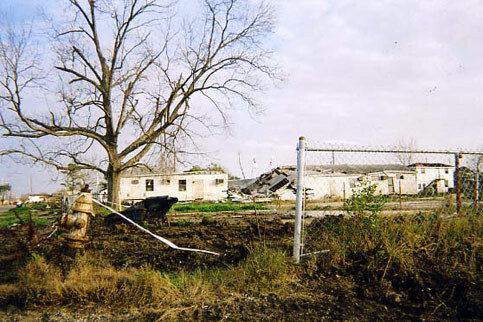
The lower Ninth Ward a year and a half after Katrina. Level 5 hurricanes are expected to become more common with the rise of global warming.
It’s no surprise that the grassroots movement that has sprung up here is calling what has happened an “ethnic cleansing.” Some people’s homes have been bulldozed without the consent of the residents. Other people have returned home to find their locks changed or their doors boarded up. Most of the projects, although habitable, have been surrounded by brand new barbed wire fences. In poorer parts of the city, rent and utility prices have doubled or tripled, making them prohibitive to former inhabitants.
One grassroots organization, the People’s Hurricane Relief Fund, recently managed to overturn legislation that would have given the city the right to claim property through eminent domain if it had not been reclaimed by its former inhabitants one year after the storm. This despite internationally recognized standards that require governments to financially support Internally Displaced Persons and to either provide compensation or to help them return home if they choose to do so.
Many who would have liked to stay through the storm were forced to leave in a ‘mandatory evacuation’ and have been scattered across the country to FEMA trailer parks, unable to return for lack of resources. The trailer parks are an American version of refugee camps. Up to nine people share a tiny trailer in the middle of nowhere. The park is surrounded by fences and checkpoints. Security guards taunt the inhabitants. No one knows when they may be kicked out or left with nowhere to go. Many are transferred from park to park every few months, given no stability, and are too exhausted from repeated trauma to have energy for fighting the bureaucracy. FEMA will not release the list of where people are, so many still have no idea where their friends and family members have been taken. Although there are many places in Louisiana where these parks could have been set up, the people have been dispersed to many different states, making it very difficult to reunite or come back to New Orleans.
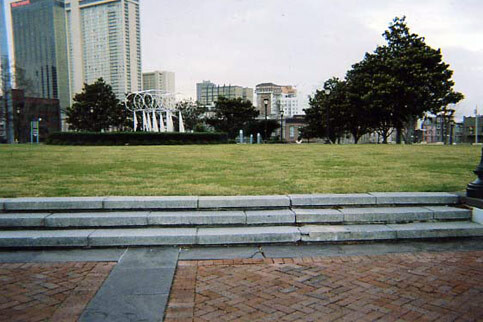
The French Quarter levee. The park in this photograph is the second level of a three-level levee that guards the French Quarter in New Orleans. This levy is considered one of the great engineering feats of this century. In order to touch the French Quarter, water must overcome thirty feet of built-up earth, spread past the brick walkway, climb the stairs, flood this park, and passthrough a massive concrete wall beyond the parking lot. The French Quarter has its own conservation committee as well. Beyond this levee, the French Quarter and downtown New Orleans, a year and a half after Katrina. (Lora Gordon)
And even if they could come back, what would they be returning to? The schools and hospitals that serve the mostly poor black community have been destroyed and have yet to be rebuilt, even as the French Quarter is once again bouncing with tourism and the Lake neighborhoods, mostly rich and white, look like a resort, completely untouched.
The black community’s cultural heritage is also under attack. A Second Line, the tradition in which local brass bands honor fellow deceased musicians by leading a funereal procession through town, used to cost around $100 for a permit and be accompanied by one or two police cars. Now the permit can cost $1000 or more and is accompanied by a parade of police cars rivaling the size of the procession. The Mardi Gras Indians — parades of folks wearing elaborate costumes emulating indigenous dress, to pay tribute to the close relationships between the black and indigenous communities during slavery times — have also come under attack. Several of the oldest artisans who make the costumes have been arrested under dubious charges since the storm.
Not surprisingly, the grassroots movement to rebuild the city and resist this ethnic cleansing has founded itself on the Right to Return, an obvious reference to the haq al-awda espoused by the Palestinian struggle for liberation. Many of the leaders of this new movement are former civil rights activists, and some were close to the Palestine Liberation Organization (PLO) in the ’70s and ’80s. It seems that right now, amidst talk of reviving the PLO, that the relationship between Black and Palestinian liberation struggles are ripe for renewal and strengthening.
The other day I went with about a hundred returning New Orleans residents and about 500 visiting volunteers on a “reoccupation action” at the St. Bernard Projects, one of the places surrounded by brand new barbed wire. There is actually nothing wrong with the buildings in the projects except dampness and some mold that can be cleaned off, and the people who lived in them still have their leases. It’s today’s American version of the British deeds many Palestinians still have — I keep expecting people to show me the keys to their houses, like so many Palestinian refugees did when I met them during trips to the Middle East.
The residents got the keys to open the gates — they still have the legal right to do so as long as they have their lease — and went in, some for the first time, to begin the process of gutting their homes and moving back in, to prevent them from being demolished. It was heartbreaking to watch people go through the contents of their lives and decide what to keep and what to throw away. Anything porous had to go, couches, stuffed animals, clothes, food, wall hangings. An entire life.
At the end of the day, at the foot of every person’s home, was an enormous pile of possessions. On the face of every returning person seemed to be the competing emotions of exhaustion and hope. The devastation of returning to your home after it had been nearly destroyed — reminding me of Palestinians who return to their villages in the ‘48 territories — combined with a determination to rebuild.
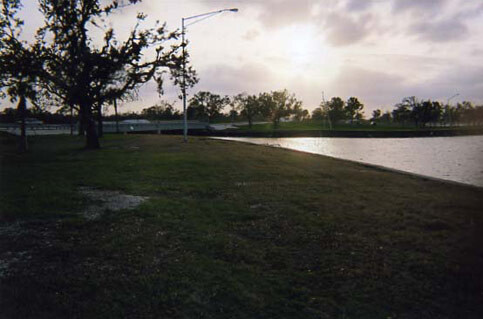
The levee at the 17th Street Canal. This park is a levee, 30 feet of earth, distributed over two hills, built up to protect the Lake neighborhoods behind it. The Lake neighborhoods, a conglomerate of residential areas along Lake Ponchetrain, are 80-100 percent white and 0-5 percent poor, according to information gathered by the Unified New Orleans Plan. Although there were significant breaches to the canal and to those levees, particularly in the Lakeview area, residents of these neighborhoods mostly had financial resources and insurance that allowed them to rebuild. A year and a half later, this part of the city looks like a resort, while the Ninth Ward is still a disaster zone. (Lora Gordon)
The problems they must overcome are much deeper and older than Katrina. This is a question of land sovereignty and self-determination. Katrina is a more graphic, more visible, better-televised version of the more covert racist, classist institutions that oil the everyday gears of the United States. America’s financial and military support for the ethnic cleansing of Palestine at the hands of the state of Israel is an extension of the same institutions.
We are witnessing the latest battle in a 500-year-old struggle, of slavery and institutions that mimic slavery, versus peoples’ struggles for liberation. The odds are enormous. $107 billion have so far gone to New Orleans, under the auspices of ‘rebuilding,’ mostly to fund the military occupation and ethnic cleansing of that city. [4] The US has sent $108 billion of direct aid to the Israeli state since the nakba of 1948. [5]
But hurricanes have flattened New Orleans before and people have always come back and rebuilt. And in Palestine and in Palestinian refugee camps, people are still holding the keys to their homes.

And in smaller font but with the same bold lettering, the poster continues, “The people of New Orleans will not go quietly in the night, becoming the homeless of countless other cities while our own homes are razed to make way for your mansions, condos, and casinos. We will join together to defend our claim, and we will rebuild our home in the image of our own dreams.” And the people of Palestine will do the same.
Lora Gordon has worked in Palestine, Lebanon, New Orleans, Pittsburgh, and Chicago. She can be reached at lora.gordon@gmail.com.
Endnotes
[1] “Rand Study Estimates New Orleans Population To Climb To About 272,000 In 2008,” Press Release, March 15, 2006. “A New Orleans battle cry: ‘We’re going to come back’,” DeWayne Wickham, August 29, 2006, USA Today.
[2] “Big Easy coming back, slowly, but surely?” Martin Savidge, NBC News, Dec 20, 2006. New Orleans City, Louisiana Statistics and Demographics (US Census 2000).
[3] The Impact of Katrina: Race and Class in Storm-Damaged Neighborhoods, Prof. John R. Logan, Brown University.
[4] “A year later, recovery in New Orleans not easy” CNN, August 30, 2006.
[5] A Conservative Estimate of Total Direct U.S. Aid to Israel: $108 Billion,
Shirl McArthur, July 2006, p. 16-17.
Related Links




